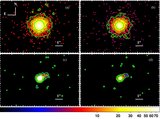Chandra Detection of Extended X-ray Emission from the Recurrent Nova RS Ophiuchi
Abstract
Radio, infrared, and optical observations of the 2006 eruption of the symbiotic recurrent nova RS Ophiuchi showed that the explosion produced non-spherical ejecta. Some of this ejected material was in the form of bipolar jets to the east and west of the central source. Here we describe X-ray observations taken with the Chandra X-ray Observatory one and a half years after the beginning of the outburst that reveal narrow, extended structure with a position angle of approximately 300° (east of north). Although the orientation of the extended feature in the X-ray image is consistent with the readout direction of the CCD detector, extensive testing suggests that the feature is not an artifact. Assuming it is not an instrumental effect, the extended X-ray structure shows hot plasma stretching more than 1900 AU from the central binary (taking a distance of 1.6 kpc). The X-ray emission is elongated in the northwest direction—in line with the extended infrared emission and some minor features in the published radio image. It is less consistent with the orientation of the radio jets and the main bipolar optical structure. Most of the photons in the extended X-ray structure have energies of less than 0.8 keV. If the extended X-ray feature was produced when the nova explosion occurred, then its 1farcs2 length as of 2007 August implies that it expanded at an average rate of more than 2 mas day-1, which corresponds to a flow speed of greater than 6000 km s-1 (days/1.6 kpc) in the plane of the sky. This expansion rate is similar to the earliest measured expansion rates for the radio jets.
- Publication:
-
The Astrophysical Journal
- Pub Date:
- December 2009
- DOI:
- arXiv:
- arXiv:0910.5484
- Bibcode:
- 2009ApJ...707.1168L
- Keywords:
-
- binaries: symbiotic;
- novae;
- cataclysmic variables;
- stars: individual: RS Ophiuchi;
- X-rays: binaries;
- Astrophysics - High Energy Astrophysical Phenomena;
- Astrophysics - Solar and Stellar Astrophysics
- E-Print:
- accepted in ApJ
